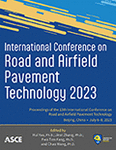Evaluation of Interaction Ability between Asphalt and Mineral Powder through Adsorbed Asphalt Film Thickness Based on Micromechanics Approach
Publication: International Conference on Road and Airfield Pavement Technology 2023
ABSTRACT
The thickness of adsorbed asphalt film is used to evaluate the interaction ability between asphalt and mineral powder. The calculation methods of the thickness of adsorbed asphalt film are proposed based on the Hashin, Mori Tanaka, and generalized self-consistent model, respectively. The influences of the acidity and alkalinity of mineral powder, test temperature, and frequency on the interactions are analyzed. The results show that the thickness of adsorbed asphalt film calculated by the Hashin model can better evaluate the interaction between asphalt and mineral powder. The higher the content of acid SiO2 in mineral powder, the weaker the interaction ability between asphalt and mineral powder. The large amount of SiO2 contained in coal gangue mineral powder inhibits the interaction ability with asphalt.
Get full access to this article
View all available purchase options and get full access to this chapter.
REFERENCES
Buttlar W G, Bozkurt D, Al-Khateeb G G. (1999). “Understanding asphalt mastic behavior through micromechanics”. Transportation Research Record, 1681(1): 157-169.
Cheng Y C, Tao J L, Jiao Y B. (2016). “Influence of the properties of powder on high and medium temperature performances of asphalt mastic”. Construction and Building Materials, 118(8): 268-275.
Christensen R M & Lo K H. (1979). “Solutions for effective shear properties in three phase sphere and cylinder models”. Mechanics and Physics of Solids, 27(4): 315-330.
Di Benedetto H, Olard F, Sauzéat C. (2004). “Linear viscoelastic behavior of bituminous materials: from binders to mixes”. Road Materials and Pavement Design, 5(9): 163-202.
Guo M. (2016). “Study on interaction mechanism and multiscale evaluation method of interfacial interaction between asphalt binder and mineral aggregate”. Harbin: Harbin Institute of technology.
Guo M, Bhasin A, Tan Y Q. (2017). “Effect of mineral powders adsorption on rheological and chemical properties of asphalt binder”. Construction and Building Materials, 141(6): 152-159.
Guo M, Tan Y Q, Yu J. (2017). “A direct characterization of interfacial interaction between asphalt binder and mineral powders by atomic force microscopy”. Materials and Structures, 50(2): 1-11.
Guo N S & Zhao Y H. (2012). “Dynamic modulus prediction of asphalt mixtures based on micromechanics”. Engineering Mechanic, 29(10): 13-19.
Hashin Z. (1962). “The elastic moduli of heterogeneous materials”. Applied Mechanics, 29(1): 143-150.
Huang S C & Robertson R E. (2006). “Rheology of thin asphalt films in contact with aggregate”. Road materials and pavement design, 7(2): 179-199.
Ke G J, Yang X F, Peng H. (2005). “Progress of research on chemical activating mechanisms of fly ash”. Journal of China Coal Society, 15(3): 366-370.
Li F, Yang Y Y, Wang L B. (2020). “Evaluation of physicochemical interaction between asphalt binder and mineral powder through interfacial adsorbed film thickness”. Construction and Building Materials, 252(8):119-135.
Li Y Q & Metcalf J B. (2005). “Two-step approach to prediction of asphalt concrete modulus from two-phase micromechanical models”. Journal of Materials in Civil Engineering, 17(4): 407-415.
Liu G Q, Jia Y S, Pan Y Y. (2020). “Quantitative comparison of evaluation indices for asphalt–powder interaction ability within powder critical volume fraction”. Road Materials and Pavement Design, 21(4): 906-926.
Mori T & Tanaka K. (1973). “Average stress in matrix and average elastic energy of materials with misfitting inclusions”. Acta Metallurgica, 21(5): 571-574.
Shashidhar N & Shenoy A. (2002). “On using micromechanical models to describe dynamic mechanical behavior of asphalt mastics”. Mechanics of Materials, 34(10): 657-669.
Tan Y Q, Li X L, Wu J T. (2012). “Influence of temperature and loading frequency on the interaction ability of asphalt and aggregate”. China Journal of Highway and Transport, 25(3): 65-72.
Tan Y Q & Guo M. (2014). “Interfacial thickness and interaction between asphalt and mineral powders”. Materials and structures, 47(4): 605-614.
Underwood B S & Kim Y R. (2014). “A four phase micro-mechanical model for asphalt mastic modulus”. Mechanics of Materials, 75(8): 13-33.
Yin H M, Buttlar W G, Paulino G H. (2008). “Assessment of existing micro-mechanical models for asphalt mastics considering viscoelastic effects”. Road Materials and Pavement Design, 9(1): 31-57.
Zhang J P, Liu G Q, Zhu C Z. (2017). “Evaluation indices of asphalt-powder interaction ability and the powder critical volume fraction based on the complex modulus”. Road Materials and Pavement Design, 18(6): 1338-1352.
Zhang Y Q & Huang X M. (2010). “Viscoelasticity prediction of asphalt mixture based on micromechanics”. Journal of Jilin University Engineering and Technology Edition, 40(1): 52-57.
Information & Authors
Information
Published In
History
Published online: Feb 6, 2024
ASCE Technical Topics:
- [Inorganic compounds]
- Acids
- Alkalinity and acidity
- Chemical compounds
- Chemical properties
- Chemicals
- Chemistry
- Construction materials
- Engineering fundamentals
- Engineering materials (by type)
- Environmental engineering
- Geomechanics
- Geotechnical engineering
- Material mechanics
- Material properties
- Materials engineering
- Measurement (by type)
- Micromechanics
- Minerals
- Organic compounds
- Silica
- Soil mechanics
- Soil properties
- Temperature effects
- Temperature measurement
- Thickness
Authors
Metrics & Citations
Metrics
Citations
Download citation
If you have the appropriate software installed, you can download article citation data to the citation manager of your choice. Simply select your manager software from the list below and click Download.
